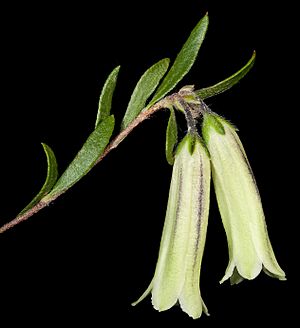Muiriantha facts for kids
Muiriantha is a special type of plant that has only one known species: Muiriantha hassellii. This plant is found only in a small area on the south coast of Western Australia. It's a small shrub with thin branches, tough leaves, and pretty yellowish-green flowers that hang downwards.
Quick facts for kids Muiriantha |
|
|---|---|
 |
|
| Scientific classification | |
| Genus: |
Muiriantha
|
| Species: |
hassellii
|
What it Looks Like
Muiriantha hassellii is a small shrub. It usually grows to be about 15 to 30 centimeters (6 to 12 inches) tall. Its small branches are covered with soft, star-shaped hairs.
The leaves grow in an alternating pattern along the stem. They are aromatic, meaning they have a smell. The leaves stand upright and are shaped like narrow ellipses. They are about 10 to 15 millimeters (0.4 to 0.6 inches) long. The leaves feel leathery and have a few soft hairs.
The flowers are fragrant and grow in clusters at the ends of the branches. These flower clusters are called inflorescence. Each flower is shaped like a tube and hangs downwards. They are about 2 to 2.5 centimeters (0.8 to 1 inch) long. Small or medium-sized leaf-like structures called bracts are found near the flowers.
Each flower has five yellowish-green petals. These petals are narrow and oblong, or shaped like an ellipse. They are rounded at the end. Each petal often has a purple or green stripe in its center. The small stalks that hold the flowers are called pedicels. They are long and have soft, weak hairs near the tips of the petals.
After flowering, the plant produces a dry fruit capsule. This capsule spreads open and ends in a sharp, short point. Muiriantha hassellii usually flowers from April to October.
How it Got its Name
The plant Muiriantha hassellii has an interesting naming history. It was first officially described in 1887 by a scientist named Ferdinand von Mueller. He first named it Chorilaena hassellii. This description was published in a science journal called the Victorian Naturalist.
Later, in 1933, another scientist named Charles Austin Gardner changed its name to Muiria hassellii. However, there was already another plant in a different family (the Aizoaceae) that had the name Muiria. To avoid confusion, Gardner changed the name again in 1943. He renamed it Muiriantha hassellii. This new name was published in the Journal of the Royal Society of Western Australia.
The second part of the plant's name, hassellii, is called the specific epithet. It was chosen to honor Albert Young Hassell. He was the person who first collected this plant from the western part of the Stirling Range.
Where it Lives
This plant has a very limited distribution. It is found only in a small part of the south-west of Western Australia. You can find it specifically at Mount Manypeaks and in the Stirling Range.
It grows in areas with heathland, which is a type of open shrubland. It prefers to grow in peaty sand or rocky clay soils on hillsides.
See also
 In Spanish: Muiriantha para niños
In Spanish: Muiriantha para niños

